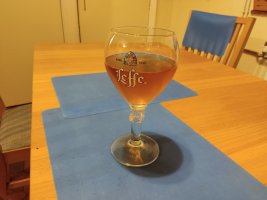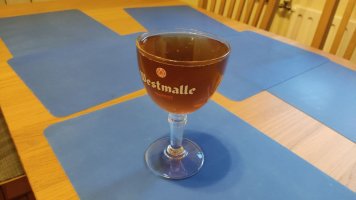mg298
New Member
Hi,
I made my first BGSA/Duval clone on 2nd Feb at OG 1.075. I followed this recipe
https://www.greatfermentations.com/belgian-golden-strong-recipe/
but by accident put in about 60% more corn sugar (instead of candi sugar) than I should have. I also (deliberately) put in about 50% extra hops, as this was the packet size. I scaled up for 24l target wort, but ended up with 28l, which is why my OG was slightly low (given the extra sugar).
I cooled the 28l wort using a chiller, made a starter (1.5l + 2l two stage, decanted), and aerated the cold wort well, using a drill before adding the decanted yeast to 24l of wort.
For fermentation I used a plastic bucket with a brew belt and went from 18 degrees celsius (day1), increasing by 1 degree each day, up to 26.5 degrees.
The FG after 23 and 26 days was 1.004, giving 9.2% abv.
I transferred to a bottling bucket and used corn sugar syrup (which I made), before bottling in 500ml swing tops and storing in a temperature controlled freezer at 26.5degrees for 4 further weeks. I targeted 3.0 volumes CO2.
To check carbonation, I chilled a bottle in the fridge (for 4-7 days) and opened it. Decent pop, felt a bit flat compared to Duval, but acceptable. The taste was better than expected at this point - unremarkable - bit thin and weak for a 9.2% Belgian, but not unpleasant. I knew it needed more time to condition and didn't think further about it.
From this point on I only chilled (and opened more bottles) if I knew people were visiting that might like to try it. The results have been surprising (to me):-
Base (2 months carb test) fine, bit plain 6/10
Base + 1 week similar 6/10
Base + 2 weeks similar 6/10
Base + 3 weeks out of this world. Like Delerium but on steroids. I was speachless - maybe my best ever beer. 9.5/10
Base + 3.5 weeks visitor says best beer they have ever had 9.5/10
Base + 4 weeks This is too easy? 9.5/10. Even the wife likes it - she hates beer.
Base + 5 weeks resembles the first bottles. It smells like the 9.5/10 but tastes like the earlier ones, with a slight bitterness to them. Maybe 7/10. I tested 3 bottles all similar. I tested with other people who also tried the 9.5/10 and agree it's not as good, with more of a bitter aftertaste and without the sweet (ester/phenol?) aftertaste that the 9.5/10 had.
My question is, does this sound like I just need to wait for longer? I had assumed things would age at roughly the same rate, particularly given they were temp controlled. I did not expect to find some of the bottles at Base+3 weeks amazing, only to find others at Base+5 weeks not ready.
If this likely is the case, when will the bottles (if ever) become more consistent with each other?
What might cause the inconsistency?
any advice appreciated
thanks in advance
mg298
I made my first BGSA/Duval clone on 2nd Feb at OG 1.075. I followed this recipe
https://www.greatfermentations.com/belgian-golden-strong-recipe/
but by accident put in about 60% more corn sugar (instead of candi sugar) than I should have. I also (deliberately) put in about 50% extra hops, as this was the packet size. I scaled up for 24l target wort, but ended up with 28l, which is why my OG was slightly low (given the extra sugar).
I cooled the 28l wort using a chiller, made a starter (1.5l + 2l two stage, decanted), and aerated the cold wort well, using a drill before adding the decanted yeast to 24l of wort.
For fermentation I used a plastic bucket with a brew belt and went from 18 degrees celsius (day1), increasing by 1 degree each day, up to 26.5 degrees.
The FG after 23 and 26 days was 1.004, giving 9.2% abv.
I transferred to a bottling bucket and used corn sugar syrup (which I made), before bottling in 500ml swing tops and storing in a temperature controlled freezer at 26.5degrees for 4 further weeks. I targeted 3.0 volumes CO2.
To check carbonation, I chilled a bottle in the fridge (for 4-7 days) and opened it. Decent pop, felt a bit flat compared to Duval, but acceptable. The taste was better than expected at this point - unremarkable - bit thin and weak for a 9.2% Belgian, but not unpleasant. I knew it needed more time to condition and didn't think further about it.
From this point on I only chilled (and opened more bottles) if I knew people were visiting that might like to try it. The results have been surprising (to me):-
Base (2 months carb test) fine, bit plain 6/10
Base + 1 week similar 6/10
Base + 2 weeks similar 6/10
Base + 3 weeks out of this world. Like Delerium but on steroids. I was speachless - maybe my best ever beer. 9.5/10
Base + 3.5 weeks visitor says best beer they have ever had 9.5/10
Base + 4 weeks This is too easy? 9.5/10. Even the wife likes it - she hates beer.
Base + 5 weeks resembles the first bottles. It smells like the 9.5/10 but tastes like the earlier ones, with a slight bitterness to them. Maybe 7/10. I tested 3 bottles all similar. I tested with other people who also tried the 9.5/10 and agree it's not as good, with more of a bitter aftertaste and without the sweet (ester/phenol?) aftertaste that the 9.5/10 had.
My question is, does this sound like I just need to wait for longer? I had assumed things would age at roughly the same rate, particularly given they were temp controlled. I did not expect to find some of the bottles at Base+3 weeks amazing, only to find others at Base+5 weeks not ready.
If this likely is the case, when will the bottles (if ever) become more consistent with each other?
What might cause the inconsistency?
any advice appreciated
thanks in advance
mg298














![Craft A Brew - Safale BE-256 Yeast - Fermentis - Belgian Ale Dry Yeast - For Belgian & Strong Ales - Ingredients for Home Brewing - Beer Making Supplies - [3 Pack]](https://m.media-amazon.com/images/I/51bcKEwQmWL._SL500_.jpg)


























